'How the north Wales sea helped my migraines'
- Published
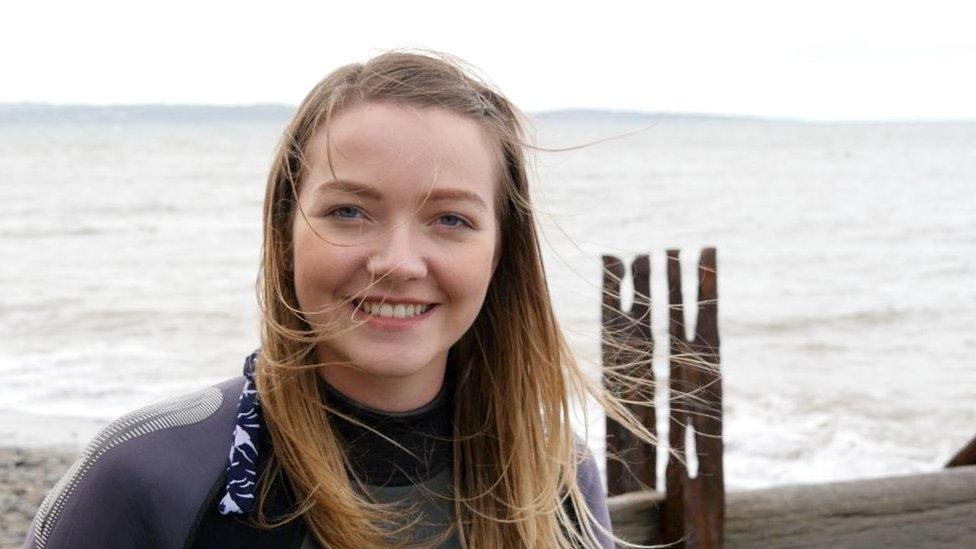
Beth used to suffer from 28 migraines a month
After being diagnosed with chronic migraines which left her in terrible pain and mostly bed-bound, Beth Francis decided to try a holistic approach to tackle her pain.
The 26-year old from Beaumaris on Anglesey embarked on a challenge to swim off the cold north Wales coast for 100 days over winter.
Here, she tells if it helped.
Imagine taking a dip in the north Wales sea during the icy months of winter.
It's what I do, even in the hammering rain or recent days of snow.
So long as the waves and currents aren't too dangerous, and I'm not putting my own or anyone else's life at risk being pulled offshore, then I'm in, headfirst into the waves.
Beth Francis: 'It's incredible'
Most of the time I swim off Anglesey - perhaps off Newborough Beach, a three-mile stretch of sand backed by tall pines, or maybe Lligwy, a beach of rolling dunes.
Usually I go in at high tide as it saves a walk down a long beach in just a swimming costume and flimsy towel.
There's hardly ever anyone about, just the occasional hardy surfer or dog walker, wrapped up in coats and wondering what I'm doing.
At the moment, the sea temperature is between 6 and 7C, depending where on the island I choose; the east is warmer.
As I dip under the waves, I take a deep breath - preparing for the cold and knowing that within a few minutes, my whole body will be tingling, numb and red.
More than this, though, I am bursting with adrenalin. Swimming like this makes me feel alive, and it's the best feeling on earth.
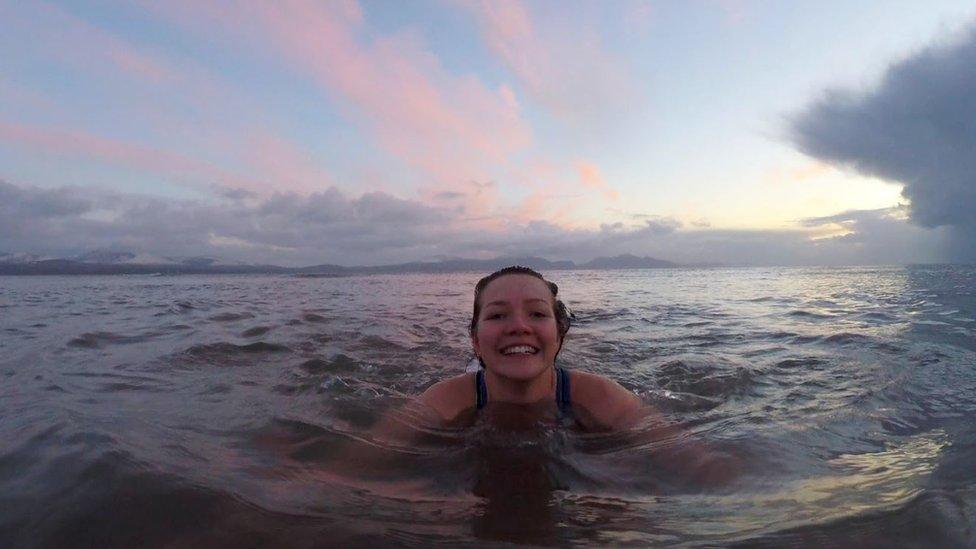
Beth wanted to see if a daily dip could help relieve her migraines
Some might think this is a form of persecution I've inflicted on myself. Others ask if I'm doing it because I've lost a bet.
In fact, I am doing this for health and healing.
Because although I might seem and look like a fit and healthy 26-year-old, last August I was diagnosed with a condition that began taking over my life; chronic migraines.
I'd suffered from migraines sporadically since the age of nine, but these were something new.
In the May of 2017, I began having two or three a week, lasting upwards of six hours at a time.
I was in my first year of a PhD in marine biology at Bangor University.
But I began losing days of work.
My migraines escalated throughout the summer, swelling to 28 attacks per month and I became so unwell that even taking a few months off work didn't help.
These weren't just headaches. They would cause tremendous pain and sensitivity to light and sounds.
I would have tinnitus, blind spots, nausea, stomach aches and sometimes become completely numb on one side.
Chronic migraine is classified by the World Health Organisation as one of the most disabling illnesses, comparable to dementia and active psychosis.
And for the majority of sufferers, normal function, including even basic tasks, is impossible during an attack.
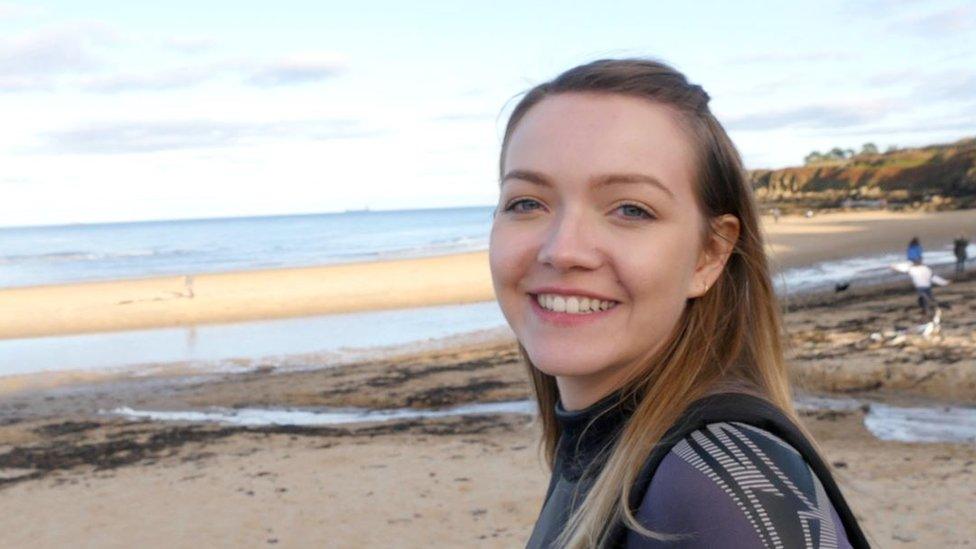
Swimming each day has helped Beth feel like her old self
My GP and neurologist prescribed differing drugs, but there is no cure for this, and the treatments were only so effective.
I'd always been active and loved the outdoors yet here I was, a young woman virtually bed-bound, despondent, hopeless and becoming less and less myself. I was losing my life.
Eventually, I began looking to the sea - something that wasn't hard to find in north Wales.
It has always played a big part in my life.
As a child, my parents would take me out in their power boat off Pwllheli, and I was building a career out of my love of the ocean.
I knew that I always felt better when I was in, or by, the ocean.
I had also read that physical activity in nature was known to aid people with a variety of health conditions.
In 2009, Prof Michael Depledge and Dr William Bird, from the European Centre for Environment and Health, based out of the University of Exeter Medical School, proposed a notion called the "Blue Gym" - the idea being that the sea can be used as motivation to exercise outdoors to influence health and wellbeing.
They found that regular contact with natural environments provided three major health benefits: reduced stress, increased physical activity and created stronger communities. They also found that people who lived 1km from the coast had much better self-reported health than those who lived inland.
I wanted to try something like that - to see if I could regain some health by connecting more with nature.
Perhaps I'd even be able to shock my body into feeling better and use the cold water as an analgesic?
Knowing how hard it would be, I set myself a challenge, along with my wonderful partner Andrew Clark, 28, to swim 100 days in the sea throughout winter.
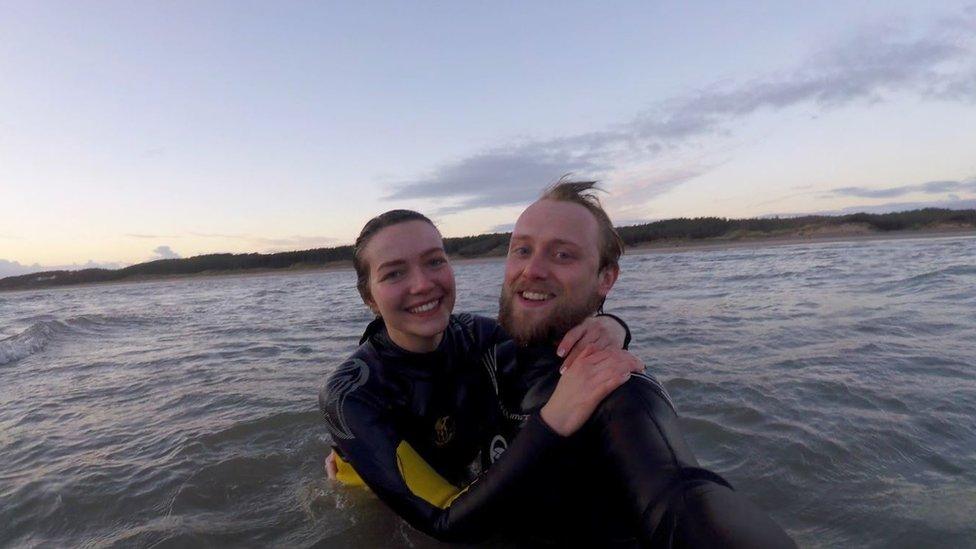
Beth and her partner, Andrew Clark, swim each day unless it is too dangerous
We committed to going in whatever the weather, so long as it wasn't dangerous or dark, and would record our adventure, external.
It wouldn't matter how long we stayed in, we decided, but we must get fully submerged.
Our first swim was on 9 October 2017 - off our local Llanddona beach - long and sandy, and forming the eastern end of Red Wharf Bay.
As we waded in, it felt so cold at 12 degrees, but we knew how much colder it would get over the next 100 days.
We stayed in the water for over an hour, swimming and playing in the waves.
And as we walked back up the sand afterwards, wind whipping at our bare legs and skin stinging from the salty water, I couldn't stop grinning.
Now, five months on and with a considerable drop in sea temperature, we stay in for shorter times, but we don't wear wetsuits.
It means we have the short sharp shock of immersion, but that we can warm up and get dressed much quicker afterwards.
Some of our brave friends have joined us for swims along the way, but mostly it is just us - two heads bobbing in a wild wintry sea, absolutely buzzing on adrenalin.
Despite the cold, it has become the absolute highlight of our day.
People might think it an odd way to combat migraines, but the change in me has been amazing.
Sometimes, I have dragged myself out of bed, eyes half closed, already suffering from a migraine, in order to complete my daily task.
But whenever this has happened, I have found the pain of migraine has dramatically reduced in severity afterwards.
My overall health has improved, and I now have about 16 migraines a month, nearly half the amount compared to when they were at their peak, and the effects aren't as debilitating.
They might last for four or five hours, as opposed to wiping out a whole day.
Obviously, I can't attribute this improvement to the medicine or the "vitamin sea" as I like to call it, in isolation.
To me, both things are acting together and holistically.
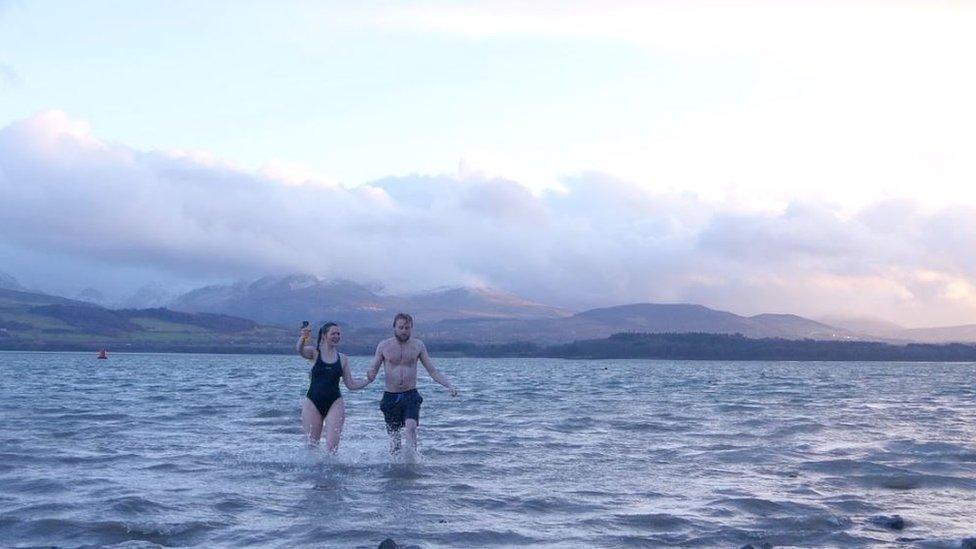
Living by and swimming in the sea has been credited to improving people's health
I don't think I would have seen this improvement without taking on this challenge.
Fundamentally, this has given me a goal to get up and out of bed, and a long way back to my old self.
I am doing something positive for my wellbeing, and feel so much more in control of my life and my illness.
No longer do I have to accept my life is confined to lying in my bed in pain.
Andy and I are now two thirds of the way through the project, with fewer than 40 swim days still to go.
But we have no plans on stopping.
We have both fallen in love with our daily dip in the ocean, and could not imagine a life without it.

An expert's view - Simon Evans, chief executive of Migraine Action
Migraine is the fifth most disabling lifetime condition in the UK.
Chronic migraine is defined as a minimum of 15 headache days a month of which at least eight are migraine. It can come with visual disturbances, nausea, light and sound sensitivity and in some cases stroke-like symptoms.
While there is no direct evidence that swimming in cold water can help relieve a migraine attack, the reported use of ice mixtures in pain relief in migraine goes back to Victorian times.
Various methods of cold and ice application have been reported on in the medical literature in recent decades with a number of theories as to why they may work.
An article in The Journal of Headache and Pain in 2015 reported good results using an intra-nasal cooling device to reduce pain.
Many of the preventative treatments for migraine were designed for other diseases and are often not well tolerated, so we are delighted that Beth has found relief for her migraine, but we suspect it won't be for everyone.

Cold water swimming - dangers and guidance (NHS Choices):
Outdoor swimming in cold water saps your body heat, so your arms and legs get weaker. If this happens, you could get into trouble if you're unable to get out of the water.
Wear a wetsuit for anything more than a quick dip
Don't jump into cold water - wade in slowly instead
Swim close to the shore
Take warm clothes to put on afterwards - even in summer you'll feel colder when you get out
Take extra care in reservoirs, which are deeper and colder than lakes and rivers
Shivering and teeth chattering are the first symptoms of hypothermia. If that happens, get out of the water and warm up
For more information, visit the RNLI's Respect The Water, external page.
- Published13 February 2018
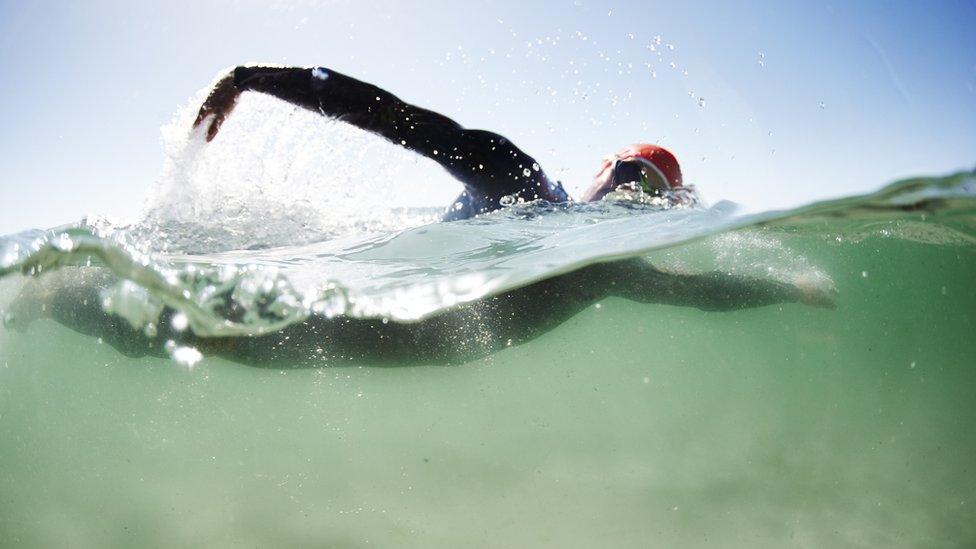
- Published11 February 2018
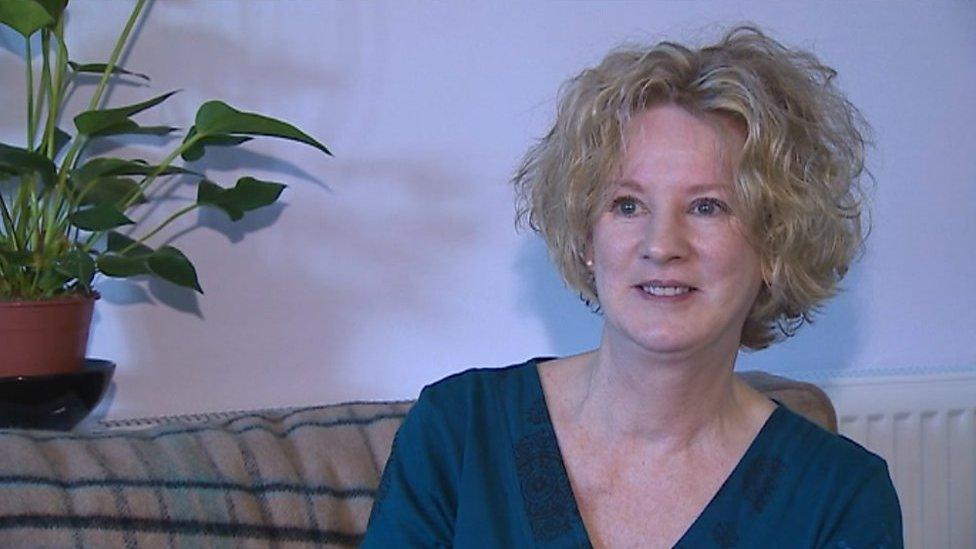
- Published10 January 2018

- Published30 November 2017
